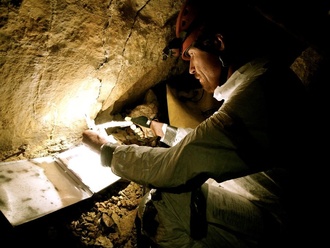Global Cave Biology Initiative
Animals use caves for various reasons. Cave swiftlets in southern Asia and islands of the South Pacific and Indian Oceans establish nesting colonies deep within caves. In Puerto Rico, boa constrictor snakes use cave entrances to hunt unsuspecting bats, while in the southwestern United States, ringtail cats hunt deep inside caves. Elephants and other large ungulates are even known to enter caves in Africa to access large salt deposits. In Central America, jaguars were so commonly encountered denning within caves that the ancient Mayas incorporated this imagery into their cosmology.
While it is known that many animals use caves, scientific knowledge is still lacking surrounding caves and their inhabitants. Global threats of deforestation, mining, groundwater pollution, climate change, cave commercialization, and other human impacts all hasten the need to assemble scientific data on how animals use caves. This information allows land managers and conservation groups to make decisions on how to safeguard these resources and may also lead to longer-term research studies in these regions.
How Can You Participate?
If you are
planning a cave expedition anywhere on the planet, you can help us with this
project. Volunteers will be asked to use primarily noninvasive techniques
including photo-documentation of all animals encountered (from entrance to back
of the cave) and animal sign (features, scat, burrowing, denning, and nesting activity,
and skeletal remains), as well as noting direct observations on animal behavior
and species interactions. When feasible and if research permits can be obtained,
we may also request that expedition teams collect invertebrates. Additionally,
we will request all participants provide coordinate data of caves, as well as
plotted locations of animal/animal sign observations on cave maps.
|

Bats – Most bat populations are in decline globally. At least half of the world’s nearly 1,300 bat species are likely to use caves for maternity roosts, bachelor roosts, hibernation and/or night roosts. Identifying bat roosts for future inventory and monitoring may help to preserve declining bat species.
How will the data be used?
This is the first effort to amass global information on the occurrence of both vertebrate and invertebrate species in caves around the world. Our objective is to develop a picture of how animals use caves, and then hopefully begin to gain some insight into why they use them. This information will be useful in guiding management and conservation decisions on both a cave-specific and a regional level. Additionally, this data may ultimately be used to develop future research and conservation projects to address questions identified by this project.
|













